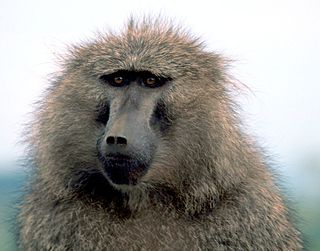Related Research Articles

The chimpanzee, also known as simply the chimp, is a species of great ape native to the forest and savannah of tropical Africa. It has four confirmed subspecies and a fifth proposed one. When its close relative the bonobo was more commonly known as the pygmy chimpanzee, this species was often called the common chimpanzee or the robust chimpanzee. The chimpanzee and the bonobo are the only species in the genus Pan. Evidence from fossils and DNA sequencing shows that Pan is a sister taxon to the human lineage and is humans' closest living relative. The chimpanzee is covered in coarse black hair, but has a bare face, fingers, toes, palms of the hands, and soles of the feet. It is larger and more robust than the bonobo, weighing 40–70 kg (88–154 lb) for males and 27–50 kg (60–110 lb) for females and standing 150 cm.

Ham, a chimpanzee also known as Ham the Chimp and Ham the Astrochimp, was the first great ape launched into space. On January 31, 1961, Ham flew a suborbital flight on the Mercury-Redstone 2 mission, part of the U.S. space program's Project Mercury.

Primatology is the scientific study of primates. It is a diverse discipline at the boundary between mammalogy and anthropology, and researchers can be found in academic departments of anatomy, anthropology, biology, medicine, psychology, veterinary sciences and zoology, as well as in animal sanctuaries, biomedical research facilities, museums and zoos. Primatologists study both living and extinct primates in their natural habitats and in laboratories by conducting field studies and experiments in order to understand aspects of their evolution and behavior.

Great ape personhood is a movement to extend personhood and some legal protections to the non-human members of the great ape family: bonobos, chimpanzees, gorillas, and orangutans.

Animal cognition encompasses the mental capacities of non-human animals including insect cognition. The study of animal conditioning and learning used in this field was developed from comparative psychology. It has also been strongly influenced by research in ethology, behavioral ecology, and evolutionary psychology; the alternative name cognitive ethology is sometimes used. Many behaviors associated with the term animal intelligence are also subsumed within animal cognition.

Research into great ape language has involved teaching chimpanzees, bonobos, gorillas and orangutans to communicate with humans and each other using sign language, physical tokens, lexigrams, and imitative human speech. Some primatologists argue that the use of these communication methods indicate primate "language" ability, though this depends on one's definition of language.
Dog intelligence or dog cognition is the process in dogs of acquiring information and conceptual skills, and storing them in memory, retrieving, combining and comparing them, and using them in new situations.

Kinji Imanishi was a Japanese ecologist and anthropologist. He was the founder of Kyoto University's Primate Research Institute and, together with Junichiro Itani, is considered one of the founders of Japanese primatology.
Ai is a female western chimpanzee, currently living at the Primate Research Institute of Kyoto University. She is the first subject of the Ai project, a research program started in 1978 by Kiyoko Murofushi and Tetsuro Matsuzawa which is aimed at understanding chimpanzee cognition through computer interface experiments.

Tetsuro Matsuzawa is a primatologist who was a past director of the Primate Research Institute of Kyoto University. He graduated from Kyoto University with a B.A. degree in 1974, a Psy.M. degree in 1976 and a Ph.D. degree in Science in 1989.

Experiments involving non-human primates (NHPs) include toxicity testing for medical and non-medical substances; studies of infectious disease, such as HIV and hepatitis; neurological studies; behavior and cognition; reproduction; genetics; and xenotransplantation. Around 65,000 NHPs are used every year in the United States, and around 7,000 across the European Union. Most are purpose-bred, while some are caught in the wild.
Primate cognition is the study of the intellectual and behavioral skills of non-human primates, particularly in the fields of psychology, behavioral biology, primatology, and anthropology.
Imitative learning is a type of social learning whereby new behaviors are acquired via imitation. Imitation aids in communication, social interaction, and the ability to modulate one's emotions to account for the emotions of others, and is "essential for healthy sensorimotor development and social functioning". The ability to match one's actions to those observed in others occurs in humans and animals; imitative learning plays an important role in humans in cultural development. Imitative learning is different from observational learning in that it requires a duplication of the behaviour exhibited by the model, whereas observational learning can occur when the learner observes an unwanted behaviour and its subsequent consequences and as a result learns to avoid that behaviour.
Number sense in animals is the ability of creatures to represent and discriminate quantities of relative sizes by number sense. It has been observed in various species, from fish to primates. Animals are believed to have an approximate number system, the same system for number representation demonstrated by humans, which is more precise for smaller quantities and less so for larger values. An exact representation of numbers higher than three has not been attested in wild animals, but can be demonstrated after a period of training in captive animals.
Theory of mind in animals is an extension to non-human animals of the philosophical and psychological concept of theory of mind (ToM), sometimes known as mentalisation or mind-reading. It involves an inquiry into whether non-human animals have the ability to attribute mental states to themselves and others, including recognition that others have mental states that are different from their own. To investigate this issue experimentally, researchers place non-human animals in situations where their resulting behavior can be interpreted as supporting ToM or not.

The cooperative pulling paradigm is an experimental design in which two or more animals pull rewards toward themselves via an apparatus that they cannot successfully operate alone. Researchers use cooperative pulling experiments to try to understand how cooperation works and how and when it may have evolved.
The cognitive tradeoff hypothesis argues that in the cognitive evolution of humans, there was an evolutionary tradeoff between short-term working memory and complex language skills. Specifically, early hominids sacrificed the robust working memory seen in chimpanzees for more complex representations and hierarchical organization used in language. The theory was first brought forth by Japanese primatologist Tetsuro Matsuzawa, a former director of the Primate Research Institute of Kyoto University (KUPRI).
Dora Biro is a behavioral biologist and the Beverly Petterson Bishop and Charles W. Bishop Professor, Brain and Cognitive Sciences at the University of Rochester. She was previously a Professor of Animal Behaviour at the University of Oxford. and a visiting professor in the Primate Research Institute of Kyoto University in Japan. Biro studies social behavior, problem solving, and learning in birds and primates.
Primate archaeology is a field of research established in 2008 that combines research interests and foci from primatology and archaeology. The main aim of primate archaeology is to study behavior of extant and extinct primates and the associated material records. The discipline attempts to move beyond archaeology's anthropocentric perspective by placing the focus on both past and present primate tool use.
References
- ↑ "Ayumu the Chimpanzee Living in the Primate Research Institute, Kyoto University - Chimpanzee Ai". Langint.pri.kyoto-u.ac.jp. Archived from the original on 23 January 2020. Retrieved 21 February 2019.
- ↑ Matsuzawa, T. (2003). "The Ai project: Historical and ecological contexts". Animal Cognition. 6 (4): 199–211. doi:10.1007/s10071-003-0199-2. PMID 14566577. S2CID 8928490.
- ↑ "Numerals - Arrows".[ permanent dead link ]
- ↑ "Chimp solves memory test 'faster than blink of an eye'". BBC. 2012.
- ↑ "5-year-old chimp beats college kids in computer game - CNN.com". 9 June 2008. Archived from the original on 9 June 2008. Retrieved 21 February 2019.
- ↑ Silberberg, Alan; Kearns, David (March 2009). "Memory for the order of briefly presented numerals in humans as a function of practice". Animal Cognition. 12 (2): 405–407. doi:10.1007/s10071-008-0206-8. ISSN 1435-9448. PMID 19115068. S2CID 7412863.